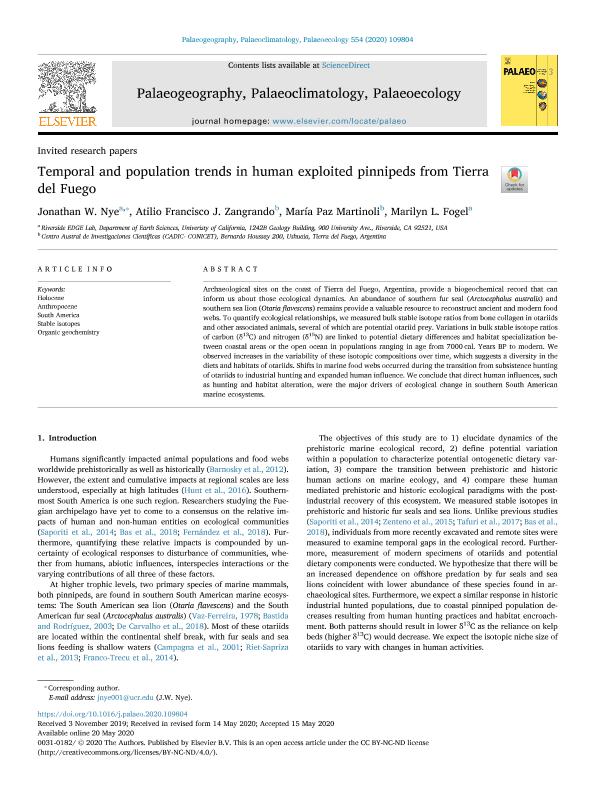Artículo
Temporal and population trends in human exploited pinnipeds from Tierra del Fuego
Fecha de publicación:
09/2020
Editorial:
Elsevier Science
Revista:
Palaeogeography, Palaeoclimatology, Palaeoecology
ISSN:
0031-0182
Idioma:
Inglés
Tipo de recurso:
Artículo publicado
Clasificación temática:
Resumen
Archaeological sites on the coast of Tierra del Fuego, Argentina, provide a biogeochemical record that can inform us about those ecological dynamics. An abundance of southern fur seal (Arctocephalus australis) and southern sea lion (Otaria flavescens) remains provide a valuable resource to reconstruct ancient and modern food webs. To quantify ecological relationships, we measured bulk stable isotope ratios from bone collagen in otariids and other associated animals, several of which are potential otariid prey. Variations in bulk stable isotope ratios of carbon (δ13C) and nitrogen (δ15N) are linked to potential dietary differences and habitat specialization between coastal areas or the open ocean in populations ranging in age from 7000 cal. Years BP to modern. We observed increases in the variability of these isotopic compositions over time, which suggests a diversity in the diets and habitats of otariids. Shifts in marine food webs occurred during the transition from subsistence hunting of otariids to industrial hunting and expanded human influence. We conclude that direct human influences, such as hunting and habitat alteration, were the major drivers of ecological change in southern South American marine ecosystems.
Palabras clave:
ANTHROPOCENE
,
HOLOCENE
,
ORGANIC GEOCHEMISTRY
,
SOUTH AMERICA
,
STABLE ISOTOPES
Archivos asociados
Licencia
Identificadores
Colecciones
Articulos(CADIC)
Articulos de CENTRO AUSTRAL DE INVESTIGACIONES CIENTIFICAS
Articulos de CENTRO AUSTRAL DE INVESTIGACIONES CIENTIFICAS
Citación
Nye, Jonathan W.; Zangrando, Atilio Francisco Javier; Martinoli, Maria Paz; Fogel, Marilyn; Temporal and population trends in human exploited pinnipeds from Tierra del Fuego; Elsevier Science; Palaeogeography, Palaeoclimatology, Palaeoecology; 554; 9-2020; 1-20
Compartir
Altmétricas




